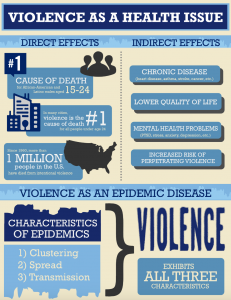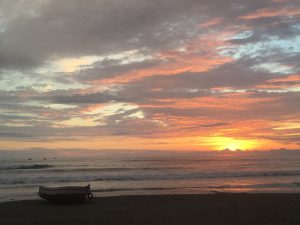 When I get sick, I usually like to pretend it’s not happening, try to act normal, operate at full capacity, fool the world…but my sneezing & coughing usually betray my confidence. Disease seems to be a recurring theme in SPP, metaphorically or literally – per today’s environmental conflict session, contagion & treatment-resistant diseases are considered a significant contemporary threat, right up there with terrorism & cyber war. Sanitation & public health issues are continually at the forefront of behavior change campaigns and arguably will remain there. When thinking of the characteristics of a sickness, one of the first questions that comes to mind is whether or not the carrier is contagious. Why? Because nobody wants to catch it. Being sick is no fun, can spread quite quickly, drains resources, and can be debilitating or life-threatening. Sounds a lot like violence, no?
When I get sick, I usually like to pretend it’s not happening, try to act normal, operate at full capacity, fool the world…but my sneezing & coughing usually betray my confidence. Disease seems to be a recurring theme in SPP, metaphorically or literally – per today’s environmental conflict session, contagion & treatment-resistant diseases are considered a significant contemporary threat, right up there with terrorism & cyber war. Sanitation & public health issues are continually at the forefront of behavior change campaigns and arguably will remain there. When thinking of the characteristics of a sickness, one of the first questions that comes to mind is whether or not the carrier is contagious. Why? Because nobody wants to catch it. Being sick is no fun, can spread quite quickly, drains resources, and can be debilitating or life-threatening. Sounds a lot like violence, no?
Punitive Justice vs. Restorative Justice. Revenge vs. Reconciliation. Harm vs. Healing. We’ve learned an extraordinary amount in these weeks, but I won’t pretend to be an expert in conflict resolution…however, I do agree that violence mimics disease in a remarkable way. It gets into the very pores of your existence, it can spread quickly, it can be debilitating like a plague, sometimes it’s out of your control, it’s contagious, an epidemic, and preys on the weak. But there is hope, and a cure is not impossible. To end violence seems daunting; when it comes to gang violence, however, there are some promising remedies worth sharing. Programs like Ceasefire and Cure Violence utilize intervention tactics, accountability, and moral authority to positively change behavior. Ceasefire uses call-ins, meetings with gang members, religious leaders, police, and community members in attendance to enforce group accountability for the actions of one. Cure Violence cleverly uses “interrupters” (intermediaries), usually former gang members, who have a higher moral authority – meaning, they are a part of the community and have the prior experience in their lives to better develop trust with the intended audience. If a young boy is at risk of joining a gang…to whom is he more likely to listen if he is to be discouraged from doing so…a policeman, or someone from his community with whom he can identify, someone who has been in his shoes? The concept of moral authority is a powerful one, and I think we seek it out more than we realize…I always trust someone more who has “been there” – because experience gives credibility. 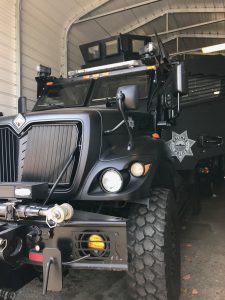
Diseases infiltrate individuals, populations, and spaces, without permission. Space can be perceived, space can be surrounded by a border, space can be a neutral zone, or space can be a physical location. Walls can be used to keep people inside a zone, or to keep them from entering. An airborne disease permeates borders, it laughs in the face of a wall. Just like violence. Space can also act as a facilitator…how? An everyday space can be a great place to pursue reconciliation. Violence can’t very well be tranquilized if the gathering is taking place on disputed territory or a place of historical marginalization. There is healing power in acknowledgement – once issues are identified and pure honesty prevails, the mending has a better shot at survival.
So what is the moral of the story? Contagion is scary, and so is violence. If we treat violence like a disease, we also must remember that it does not excuse violent behavior or label a culpable individual free from accountability…but it certainly helps explain the actions of individuals who have walked down the path of violence. In order to treat a disease, we must understand its behavior. The studies of behavior and attitude are far from simple, nor are they short term goals; however, it is fundamental to understand their genetic makeup if we are to successfully develop the antidote to cure violence.



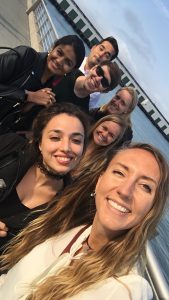 (There is something about the arts that is just a great escape from reality.) The concept of identity can be challenged, questioned…people are comfortable with order and categories. Sometimes, things don’t fit into a box quite so neatly. Life is messy. In the story line, Jean Valjean is struggling with his previous life-identity as a prisoner (24601) and sings about having been put into prison only for stealing a loaf of bread. He is tried, sentenced, paroled, and struggles to find a new life purpose because society, embedded structural violence, poverty, and stigmas are cruel to his attempts at searching for a new purpose. No one will give him a chance or see him as anything but a prisoner. Always told to “look down.” If people tell you are worthless enough times, self-fulfilling prophecy may seem like the only way out. I’m a thief? Ok, I’ll steal. You call me a felon? Ok, I’ll be one. It certainly could seem like the viable option, but it isn’t the only one. A priest defends him in front of the authorities, despite his shortcomings, and that is when he makes a decision to become an honest man, that his past will not dictate his future.
(There is something about the arts that is just a great escape from reality.) The concept of identity can be challenged, questioned…people are comfortable with order and categories. Sometimes, things don’t fit into a box quite so neatly. Life is messy. In the story line, Jean Valjean is struggling with his previous life-identity as a prisoner (24601) and sings about having been put into prison only for stealing a loaf of bread. He is tried, sentenced, paroled, and struggles to find a new life purpose because society, embedded structural violence, poverty, and stigmas are cruel to his attempts at searching for a new purpose. No one will give him a chance or see him as anything but a prisoner. Always told to “look down.” If people tell you are worthless enough times, self-fulfilling prophecy may seem like the only way out. I’m a thief? Ok, I’ll steal. You call me a felon? Ok, I’ll be one. It certainly could seem like the viable option, but it isn’t the only one. A priest defends him in front of the authorities, despite his shortcomings, and that is when he makes a decision to become an honest man, that his past will not dictate his future.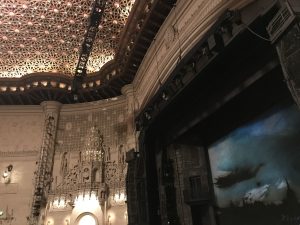
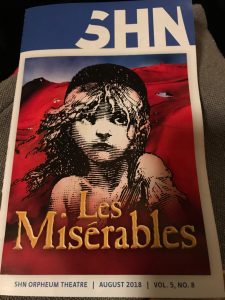 those who are different from us. We are a world of bleeding identities and connectedness, constantly crossing man-made boundaries. If we can shift the focus to include all parties in any narrative, everyone has a stake in the game, and we can then move the lens through which an issue is viewed. Bringing it back to Les Mis, the character Fantine repeatedly struggles with her identity after she is fired from her workplace. She has a daughter for whom she must provide; and in this moment, her identity as a mother is the most important thing. She sacrifices her hair, her body, and her soul in order for a little bit of money for her child, to be the best mother she can be. We have all experienced identity crises, I imagine, at one point or another in our lives, to varying degrees. What should I be doing with my life? What is my ethnicity? Do I agree with my religion? Questions are healthy, and your identity should come from within you, not what society decides to impose upon you.
those who are different from us. We are a world of bleeding identities and connectedness, constantly crossing man-made boundaries. If we can shift the focus to include all parties in any narrative, everyone has a stake in the game, and we can then move the lens through which an issue is viewed. Bringing it back to Les Mis, the character Fantine repeatedly struggles with her identity after she is fired from her workplace. She has a daughter for whom she must provide; and in this moment, her identity as a mother is the most important thing. She sacrifices her hair, her body, and her soul in order for a little bit of money for her child, to be the best mother she can be. We have all experienced identity crises, I imagine, at one point or another in our lives, to varying degrees. What should I be doing with my life? What is my ethnicity? Do I agree with my religion? Questions are healthy, and your identity should come from within you, not what society decides to impose upon you.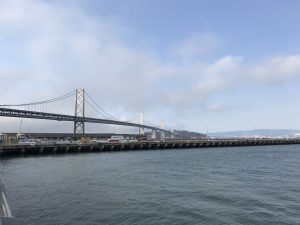 Our waiter was kind enough to tell his story – he had a career and family he loved, but alcoholism got the better of him. He came to Delancey Street Foundation to get back on his feet and throw himself into his work. It’s a 2-year commitment, it helps them make amends with loved ones, and teaches conflict resolution and behavior change through correcting each other, nonviolently, while playing games and through mentorship. If only Jean Valjean had such a place to go…everyone deserves a chance to make amends; your future is yours… “when the beating of your heart echoes the beating of the drums, there is a life about to start when tomorrow comes.”
Our waiter was kind enough to tell his story – he had a career and family he loved, but alcoholism got the better of him. He came to Delancey Street Foundation to get back on his feet and throw himself into his work. It’s a 2-year commitment, it helps them make amends with loved ones, and teaches conflict resolution and behavior change through correcting each other, nonviolently, while playing games and through mentorship. If only Jean Valjean had such a place to go…everyone deserves a chance to make amends; your future is yours… “when the beating of your heart echoes the beating of the drums, there is a life about to start when tomorrow comes.”
